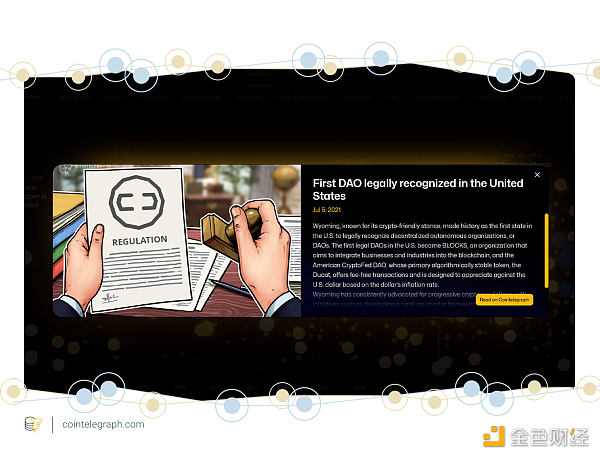Author: Derek Andersen, CoinTelegraph; Translator: Deng Tong, Golden Finance
The pandemic that broke out in early 2020 wreaked havoc on human life and the world economy. The crypto world was also hit hard, with crypto markets plummeting in March of that year. Bitcoin lost 52% of its value in a day, Ethereum lost 43%, and the decentralized finance sector (DeFi) plummeted.
The resulting lockdown had a slow but more far-reaching impact on cryptocurrencies. With most people staying at home and spending more time in front of their screens steadily increasing, interest in cryptocurrencies and their market capitalization soared. Soon, emerging technologies were being developed and implemented at an unprecedented rate.
Related content:
Tracing the History of Cryptocurrency (I): Satoshi Nakamoto’s Response to the Financial Crisis
Tracing the History of Cryptocurrency (II): The Joining of Ethereum and the Surge of Bitcoin
Tracing the History of Cryptocurrency (III): The ICO Boom and the Evolution of Ethereum
Tracing the History of Cryptocurrency (IV): The Great Crash and Ethereum’s Mainstream Recognition

DeFi Explodes
DeFi took its first steps in 2017 with the development of smart contracts on the Ethereum blockchain. MakerDAO and Compound were early market leaders. In June 2020, Compound introduced liquidity mining, also known as liquidity mining, which is an arbitrage method of transferring crypto assets to obtain the highest interest, fees, and rewards. It is now a common practice.
Compound is also a pioneer in decentralization. COMP is also the first governance token that enables users to directly participate in the management of decentralized autonomous organizations (DAOs). By the end of the year, the decentralization of many DAOs was progressing smoothly.
The DAO is an organization governed by enforced digital rules and has no hierarchical management. It is similar to Bitcoin in that it attempts to get rid of all middlemen in transactions.

By September 2020, DeFi collateral had jumped to $9 billion from $700 million at the beginning of the year. Around that time, Bloomberg wrote:
“A cryptocurrency craze known as decentralized finance has helped digital currencies become the best-performing asset so far this year.”
Decentralized exchanges (DEXs) have also played a major role. These already exist in 2020, with OasisDEX launching in 2016 and Uniswap appearing in 2018. DEXs allow users to trade crypto assets peer-to-peer, i.e. without intermediaries. Decentralized exchanges, in turn, gave rise to automated market makers that leverage liquidity mining.

Uniswap logo, Source: Uniswap
All of this activity ultimately resembled a bubble, or a “period of price explosion,” which the crypto world dubbed the DeFi Summer of 2020.
The Third Bitcoin Halving
The third Bitcoin halving took place on May 11, 2020, just before the start of the DeFi summer. Halving means that for every 210,000 BTC mined, the mining reward is reduced by 50%. In 2020, the reward for mining a block was reduced to 6.25 BTC. BTC/USD 1-month historical trading chart. Source: TradingView The purpose of halving is to prevent inflation by slowing down mining and to increase demand by slowing production. During the third halving, BTC was selling for around $8,800. It saw a small rise in July and August 2020 and began a significant upward trend in October, rising to $63,000 by April 2021.
2021: The Year of the NFT
Non-fungible tokens (NFTs) are unique digital items on the blockchain. Their history also dates back several years, but it wasn't until 2021 that the market really took off. They are at the heart of today's craze for tokenizing real-world assets and have been used for ticketing, licensing, gaming, authentication, music, and many other uses. Their earliest uses were in gaming, collectibles, and art.

CryptoKitties, Source: CryptoKitties
CryptoKitties was an early look at things to come. Developed by Dapper Labs and launched in 2017, the game uses NFTs to collect, trade, and breed digital virtual cats. Cointelegraph later noted: “The digital cat breeding blockchain game caused considerable congestion on the Ethereum blockchain, which peaked in 2020.” The CryptoPunks series of collectibles also launched in 2017. The Bored Ape Yacht Club series launched in April 2021. Creator Yuga Labs sold all 10,000 by the end of the month, raising $3 billion. The company then launched the lower-cost Mutant Ape Yacht Club in August 2021, which is still being minted today.

Examples of Bored Ape Yacht Club and Mutant Ape Yacht Club NFTs. Source: BAYC
In 2017, there were about 120,000 NFT users. In 2020, the number of users increased to 1 million, in 2021 to 3.5 million, and in 2022 to 9.9 million. NFT revenue grew nearly 40,000% between 2019 and 2021, but fell sharply in 2022. The OpenSea marketplace, founded in 2017, had 87% of the NFT market at the beginning of 2022, but trading volume fell 99% that year. Regardless, NFT revenue continues to grow and is expected to reach $2.4 billion by 2024.
 Miami Web3
Miami Web3






